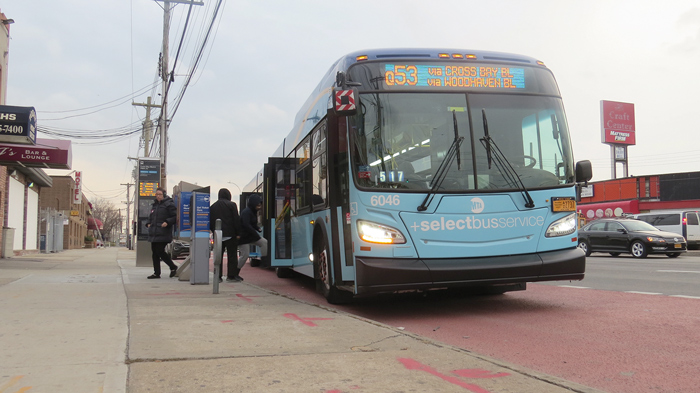File Photo
The Queens Bus Network Redesign calls for the elimination of the Q53.
By Michael V. Cusenza
Borough residents will have even more opportunities to tell the Metropolitan Transportation Authority how they truly feel about the draft plan of the Queens Bus Network Redesign—wildly unpopular in these parts, thanks to its proposal to eliminate the Q53, among other drastic ideas—as the beleaguered agency has added more public outreach events to its itinerary.
Some of the new community meeting dates include:
- Tuesday, Feb. 11, 6-8 p.m. (presentation)
York College, Faculty Dining Room
94-20 Guy R. Brewer Blvd., Jamaica
- Wednesday, Feb. 12, 7 p.m. (presentation)
Kew Gardens Community Center
80-02 Kew Gardens Rd.
Ste. #202, Kew Gardens
- Wednesday, Feb. 12, 6:30-8:30 p.m. (presentation)
PS/IS 49
63-60 80th St., Middle Village
- Wednesday, Feb. 19, 6:30-8:30 p.m. (presentation)
Queens College
65-30 Kissena Blvd., Flushing
- Thursday, March 12, 6:30-8:30 p.m. (workshop)
August Martin High School
156-10 Baisley Blvd., Jamaica
In December, the MTA released a draft plan to “dramatically” redraw the Queens Bus Network for the first time in 100 years.
Apparently, it is in desperate need of a thorough makeover. The current sluggish system is composed of 77 routes within a widespread network that has three centers in downtown Flushing, downtown Jamaica, and Long Island City. The average bus speed in The World’s Borough is 8.7 miles per hour, continuing an overall borough-wide slowdown since 2015, according to MTA New York City Transit. Roughly 52 percent of Queens’ 2.3 million residents rely on public transit for their daily commutes; 11 percent of those commuters rely solely on buses. More than 94 percent of Queens residents live within a five-minute walk of a bus stop. Bus stops in the borough are spaced very close together, leading to frequent bus stopping and longer commutes, MTA officials noted. Many stops are 500 to 1,000 feet apart, which, according to the MTA, is shorter than the average bus stop spacing system-wide and far closer than peer transit systems worldwide.
The sweeping 432-page draft proposal, according to MTA officials, seeks to completely redraw the bus routes, which were mostly unchanged since they were converted from old trolley lines from the turn of the 20th century or consolidated from private bus companies that began serving Queens in the 1910s. Many of those companies served three central hubs in Queens, leading to three separate spoke-and-wheel networks to Flushing, Jamaica, and Long Island City that severely limited the coverage area.
The draft plan takes into consideration the service performance of each bus route, the speed, ridership and reliability on key corridors, and how individual routes contribute to the larger network. Recommendations were developed in collaboration with the City Department of Transportation, with focus given to identifying key corridors where roadway treatments and traffic signal improvements can be implemented to expand bus priority and better support sustainable, all-day bus service. The details of DOT’s proposed bus priority plan for Queens are included in the draft plan.
For more information on the proposal, visit new.mta.info/queensbusredesign.

